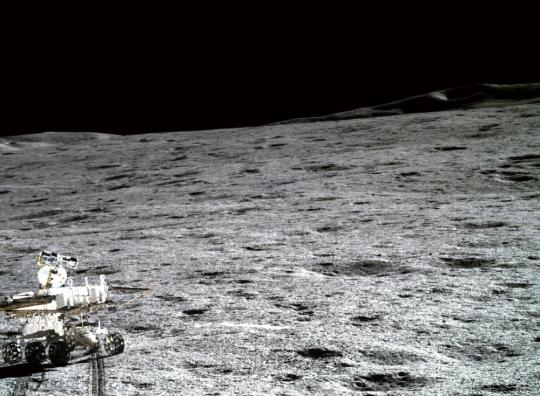Chang'e-4 reveals the history of multiple small celestial collisions at the landing site on the back of the moon
The surface of the moon photographed by the Chang'e-4 lander.
(Photo provided by interviewee)
Xinhua News Agency, Beijing, September 9th (Reporter Liu Yiwei and Yu Fei) Chinese researchers conducted in-depth research on the Yutu-2 radar detection data, and obtained important discoveries and understandings of the lunar soil and shallow fine structure in the Chang'e-4 landing area, showing This area has experienced many small celestial impact sputter accumulations and volcanic eruptions, revealing the evolution history of the moon’s oldest and largest impact basin.
Chang'e-4 became the first probe in human history to successfully land on the back of the moon on January 3, 2019. Its landing site is located in the Von Kamen impact crater in the Antarctic-Aitken Basin.
The Yutu 2 lunar rover is equipped with many scientific detection instruments including radar, which can realize in-situ detection of the lunar surface material composition and shallow structure.
Scientists can recover the impact history experienced by the Antarctic-Aitken Basin based on the detection data, and on this basis, reveal the deep material composition of the moon.
Research teams from the Institute of Geology and Geophysics of the Chinese Academy of Sciences, the Institute of Aerospace Information Innovation, and the Macau University of Science and Technology and other scientific research institutions conducted in-depth research on the radar detection data of the first three months.
The results of the study showed that the lunar surface material detected by Yutu 2 came from the nearby Finsen impact crater, not from the filling basalt of the von Kamen impact crater itself.
At the same time, the radar profile also revealed that the landing zone had experienced multiple impact events with the accumulation of sputters and the eruption and filling of basalt magma.
According to experts, the impact of small celestial bodies is an important driving force for the early evolution of the earth, but long-term geological tectonic activities have erased most of the traces of its early evolution.
The moon has a relatively small mass and ceased its internal activities very early. Therefore, the impact craters on the moon's surface and the accumulation profile of impact crater sputters more completely record the impact history of small celestial bodies in the Earth-Moon space.
On the other hand, the strong impact has also profoundly transformed the original lunar shell material.
The material on the moon's surface is often a mixture of spatters from different impact events, and some even originate from areas hundreds or even thousands of kilometers away.
Lin Yangting, a researcher at the Institute of Geology and Geophysics of the Chinese Academy of Sciences, said that the shallow structure of the moon records the number and scale of large-scale impact events and magma eruptions, as well as the time-space relationship between them.
Although the shallow structure of the moon is so important, so far, human understanding of the fine structure of the moon is still very limited.
"The impact of small celestial bodies on the transformation of the lunar surface material directly affects the detection results of the moon's orbital detection and landing patrol, and involves how to implement future moon sampling and return missions." Lin Yangting said.
The results were published in the latest issue of "Nature·Astronomy" journal.

